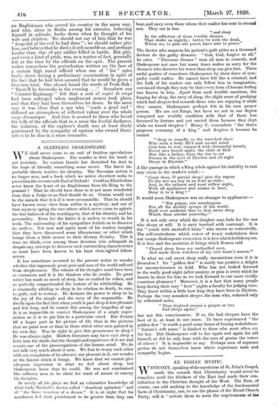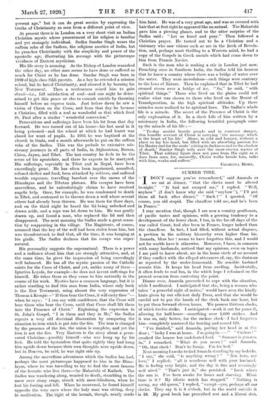AN INDIAN MYSTIC.
WESTCOTT, speaking of the mysticism of St. John's Gospel, made the remark that Christianity would never be complete until the thinkers of the East had made their con- tribution to the Christian thought of the West. The East, of course, can add nothing to the knowledge of the fundamental facts of Christianity, nor, to use the phrase of the Broad Church Party, will it "restate them to, meet the requirements of the present age," but it can do great service by expressing the truths of Christianity as seen from a different point of view.
At present there is in London on a very short visit an Indian Christian mystic whose presentment of his religion is familiar
and yet strangely individual. Sadhu Sunder Singh wears the saffron robe of the Sadhus, the religious ascetics of India, but he preaches Christianity with the simplicity and power of the apostolic age, illustrating his message with the picturesque vividness of Eastern mysticism.
His life story is amazing. As the Bishop of London remarked the other day, no other man seems to have done or suffered so much for Christ as he has done. Sunder Singh was born in 1889 of high-class Sikh parents. As a boy he attended a mission school, but he hated Christianity, and showed it by burning his New Testament. Then a restlessness seized him to gain
shanti—i.e., full satisfaction of soul—and one night he deter- mined to get this peace or else to commit suicide by throwing
himself before an express train. Just before dawn he saw a vision of Christ on the Cross, and from that day he became a Christian, filled with a zeal as wonderful as that which fired St. Paul after a similar "wonderful conversion."
Persecutions and sufferings have been his lot from that day forward. He -was turned out of his home—his last meal in it
being poisoned—and the school at which he had learnt was closed for want of pupils. In 1905, he was baptized at the church in Simla, and a month afterwards he put on the saffron robe of the Sadhu. This was the prelude to extensive mis- sionary journeys in all parts of India, in Afghanistan, Burma, China, Japan, and Tibet. The last country he feels to be the scene of his apostolate, and there he expects to be martyred.
His sufferings, especially in Tibet and in Nepal, have been exceedingly great. He has often been imprisoned, assaulted, refused shelter and food, been attacked by robbers, and suffered terrible exposure, travelling barefoot over the snows of the Himalayas and the Tibetan plateau. His escapes have been marvellous, and he unhesitatingly claims to have received angelic help. Once, for example, he was condemned to death in Tibet, and sentenced to be thrown down a well where several others had already been thrown. Ile was there for three days, and on the third night he heard the lid being unlocked and drawn aside, and a rope was let down to him. He was gently drawn up, and found a man, who replaced the lid and then disappeared. The next morning the Sadhu made a great sensa- tion by reappearing in the village. The Magistrate, of course, assumed that the key of the well had been stolen from him, but was thunderstruck to find that, all the time, it was hanging at his girdle. The Sadhu declares that his escape was super- natural.
His personality suggests the supernatural. There is a power and a radiance about him that are strongly attractive, and, at the same time, he gives the impression of being exceedingly
well balanced. He has all the mystic passion of the Catholic saints for the Cross of Christ, and yet, unlike many of them—
Ignatius Loyola, for example—he does not invent sufferings for himself. Ho takes them as they come to him naturally in the course of his work. Mystics have a common language, but it is rather startling to find this man from India, whose only book
is the New Testament, using almost the very expression of Thomas a Kempis—" If thou bear the Cross, it will carry thee "-
when he says : "I can say with confidence, that the Cross will boar those who bear the Cross, until that Cross shall lift them into the Presence of Christ." Explaining the expression in St. John's Gospel, "I in them and they in Me," the Sadhu repeats a very old doctrinal illustration by comparing the situation to iron which is put into the fire. The iron is changed by the presence of the fire, the union is complete, and yet the iron is not the fire. Very Eastern is the story about a perse- cuted Christian—possibly himself—who was hung up by his feet. He told the bystanders that quite rightly they had hung him upside down because their own thoughts were upside down, but in Heaven, he said, he was right side up.
Among the marvellous adventures which the Sadhu has had, perhaps tho most picturesque happened to him in the Hima- layas, where he was travelling to try to find the most famous of the hermits who live there—the Maharishi of Kailash. The Sa.dhu was wandering along, wearied to death, stumbling in tho snow over stony crags, struck with snow-blindness, when he 'lost his footing and fell. When he recovered, he found himself 'opposite the very cave where the holy man was sitting, deep in meditation. The:sight of the hermit, though, nearly made
him faint. He was of a very great age, and was so covered with hair that at first sight he appeared like an animal The Maharishi gave him a piercing glance, and to the utter surprise of the Sadhu said : "Let us kneel and pray." Then followed a
Christian prayer. He turned out to be a Christian and a visionary who saw visions such as are in the Book of Revela- tion, and, perhaps most thrilling to a Western mind, he had a copy of the Gospels in Greek uncials which had como down to him from Francis Xavier.
Such is the man who is making a stir in London just now. Preaching once in Southern India, the Sadhu told his hearers that he knew a country where there was a bridge of water over the water. They were incredulous—such things were contrary to the laws of Nature. Then he explained that in Tibet he had crossed rivers over a bridge of ice. "So," he said, "with spiritual things." Those who lived on the plains could not realize what was shown to those who lived on the Mount of Transfiguration, in the high spiritual altitudes. Up there miracles were realized to be spiritual laws. Tho Sadhu's whole life is a miracle. The secret of the Presence of Christ is the only explanation of it. In a short Life of him written by a missionary in India, the following beautiful paragraph sums up the miracle of his life :— " To-day amidst hostile people and in constant danger, this humble servant of Christ is carrying 'the message which is the heart of his life.' Alone, in cold and hunger, without a place to lay his head, but filled with an absorbing passion for his Master and for the souls' sitting in darkness and in the shadow of death,' Sundar Singh toils over the snow-strewn wastes of Tibet. That solitary figure does not pass from His sight as it does from ours, for, assuredly, Ch rist walks beside him, talks with him, works and suffers."
GEoRarga HOME.



































 Previous page
Previous page